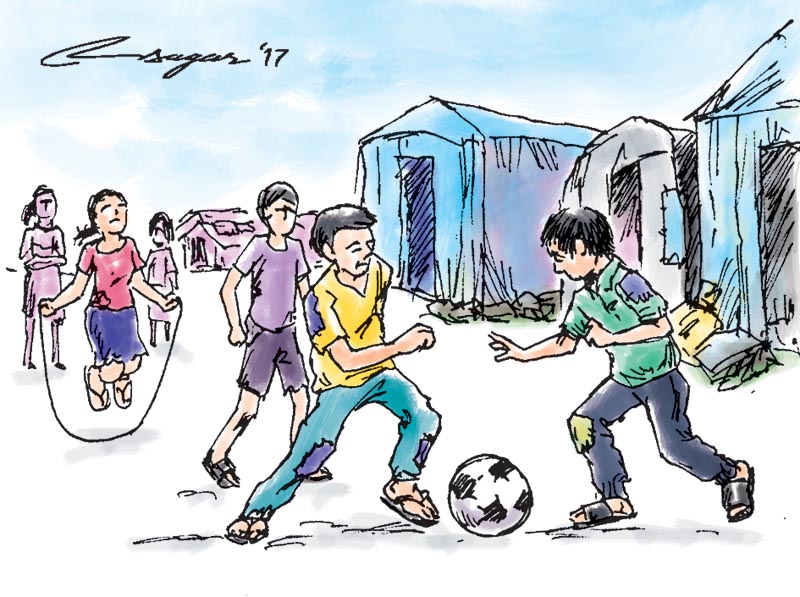World Children’s Day: Reflecting on its meaning
Human development is fundamentally centered on the equal advancements in two particular areas, education and health, both determinants of a child’s material and emotional well-being. Without ensuring their universal rights to both education and health, the future of the children is in jeopardy
The 20th of November was World Children’s Day, and perhaps such commemorations, with their nature purely symbolic, offer citizens and policymakers alike an opportunity for reflections, rather than declarations, on the life prospects of the children of this country.
As UNICEF, the “custodian” of celebrations, says, “the costs of the pandemic for children are immediate and, if unaddressed, may last a lifetime. It’s time for generations to come together to reimagine the type of world we want to create”.
As we know, kids, especially those from most vulnerable backgrounds, have been having tough times in Nepal, too.
Human development is fundamentally centered on the equal advancements in two particular areas, education and health, both determinants of a child’s material and emotional well-being. Without ensuring their universal rights to both education and health, the future of the children is in jeopardy.
Nepal has been advancing to ensure better educational and health provisions for its youngest citizens, but only so much can be achieved without fundamentally rethinking the system approach to both of them.
The government, working with external development partners, has achieved important milestones in both child’s mortality and educational enrollment rates. Its overall efforts have paid off but only to some extent actually.
We are still very far from ensuring the highest standards that would include the country among the trailblazers of human development.
In 2019, the country made timid progress in the global Human Development Report, with a rank of 147, well behind the best peer in the region, Sri Lanka, positioned 71.The latter has been through a civil war that was extremely costly in terms of sufferings with a death toll and overall devastation much higher than what Nepal experienced during its internal conflict.
At the same time, if you consider Afghanistan, positioned 170, a country devastated by a conflict that still goes on, you easily figure out that Nepal’s overall performances have been pretty much abysmal.
Donors in the health sector have been focussing on the key “golden 1,000 days, leaving to the government the responsibility to build a modern post-natal health system.
This clearly did not happen, or better it did but in a different way, unintentionally or perhaps instead intentionally, and therefore by collusion when the political class allowed the private entity to take over the sector. We are witnessing the consequences these days.
The same can be said for the education sector. Donors have been pushing for access and enrollment, and no matter their good intentions, there has been no evident progress in terms of quality education. Once again policy making by delegation or dereliction of responsibilities occurred and a “corporatisation” of the education sector followed.
If you are lucky enough to have privilege and wealth, the scenario is not that bad after all because you can always buy your ticket to health and education services, not exactly at par with international standards but, in certain cases, close enough.
However, if it so happens that you are less lucky and face poverty, vulnerability and, yes, oftentimes systemic discrimination, then the picture is not that good at all.
You are on your own, or better the only chance you have is to rely on under-resourced public facilities.
The idea that local communities can be in charge of public services, especially in the education sector, is on paper brilliant, but, without adequate support, the outcomes will be just consequential: denial and deprivation of millions of children of their universal and constitutional rights.
The delivery of quality services won’t happen without investing in human resources and infrastructure.
In the specific case of education, inclusive and free quality learning will not materialise without ensuring that the only individuals allowed to teach are true professionals ready to help their students find their life paths, showing that no matter your background, their future can be promising, too.
Sujit Maharjan is a great example of what the best educators should have: dedication, readiness to put many hours to prepare their classes and a contagious passion for teaching.
Still young, he has been teaching for several years and is undertaking a Master’s Degree in Education.
He aims to be the best he can as an educator, working very hard because he loves his job or better his vocation.
He shares with me that having in place a proper monitoring and evaluation system is paramount. According to him, “there should be a proper system of monitoring and evaluation in every school so that people who actually work and put an effort get the appreciation and the value they deserve. Most of the times, one person does the work and another gets the raise, so, in order to prevent this from happening, we should build a system to evaluate the right candidate”.
In short, the best way to follow up on World Children’s Day is to have a serious discussion on how to have more Sujits, not only in the local schools but also in every single endeavour run by the state.
Ensuring a culture of accountability and putting the clients, therefore the citizens at the centre, or as Sujit advocates about the educational system, having the learner as the epicentre of the teaching experience, is going to be key.
This will require not only money but also the capacity to do strategic thinking to attract the best minds and equip them with the tools they deserve so that every child in Nepal will have a true chance at life.
Galimberti is the co-founder of ENGAGE, an NGO partnering with youths living with disabilities. simone_engage@yahoo.com






